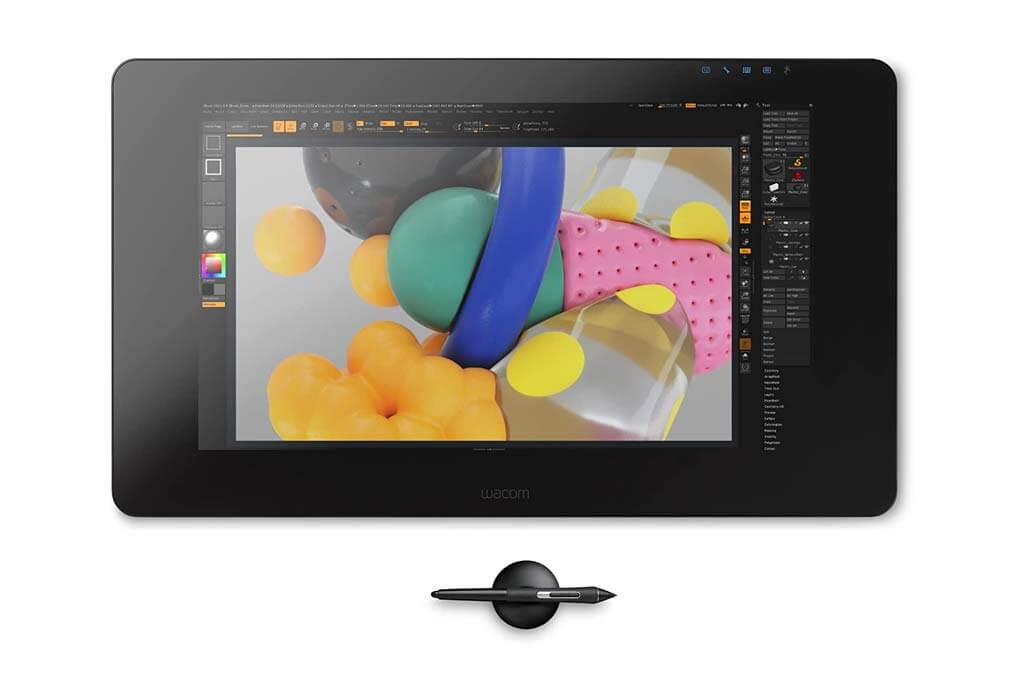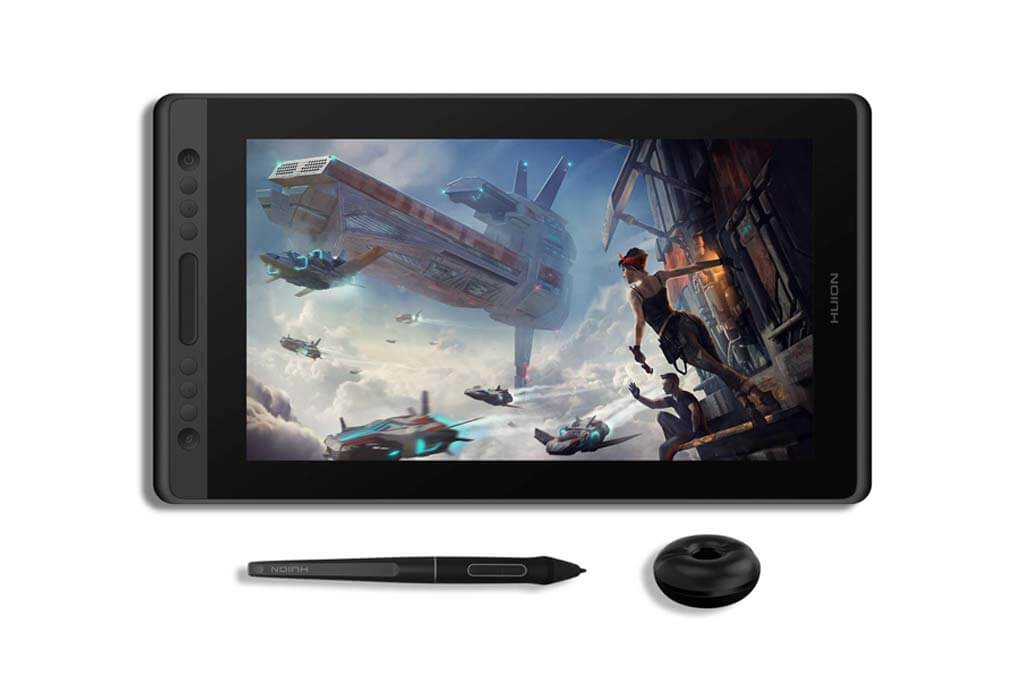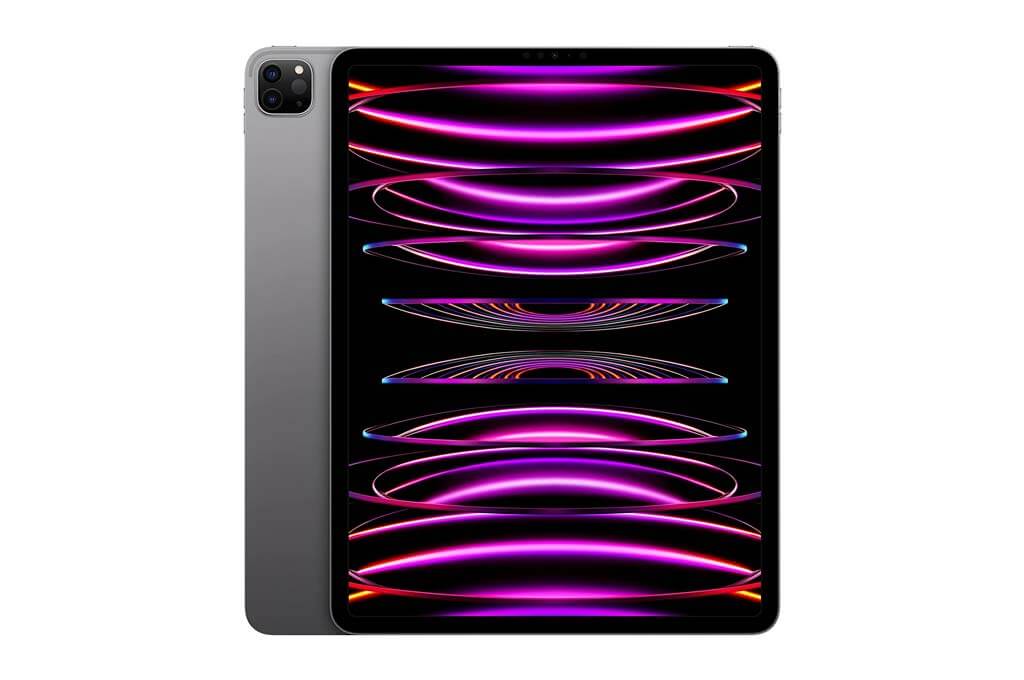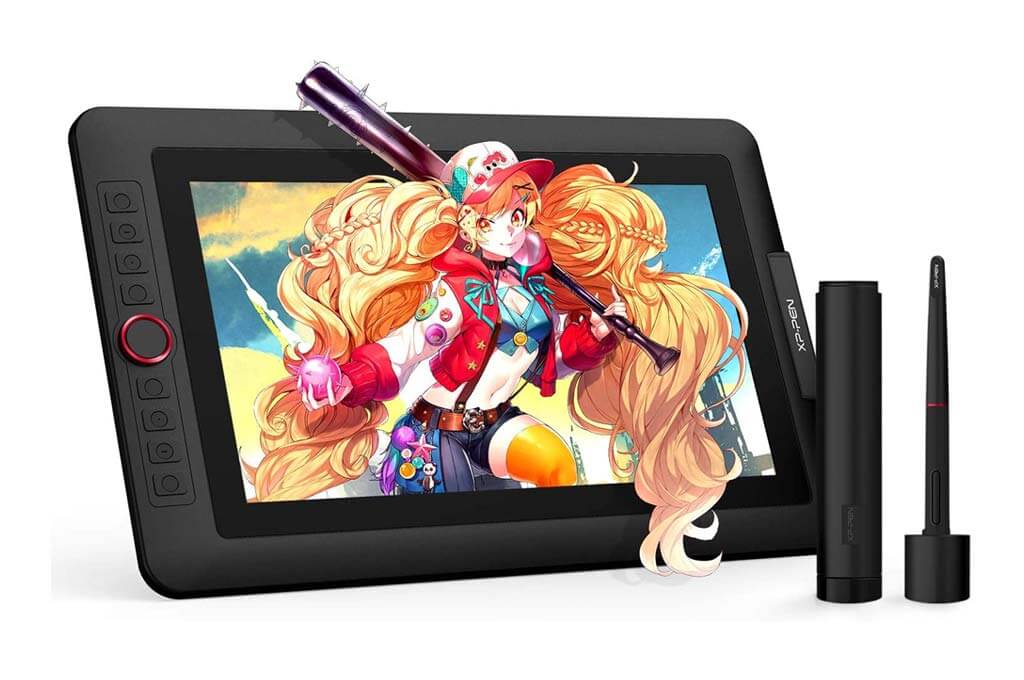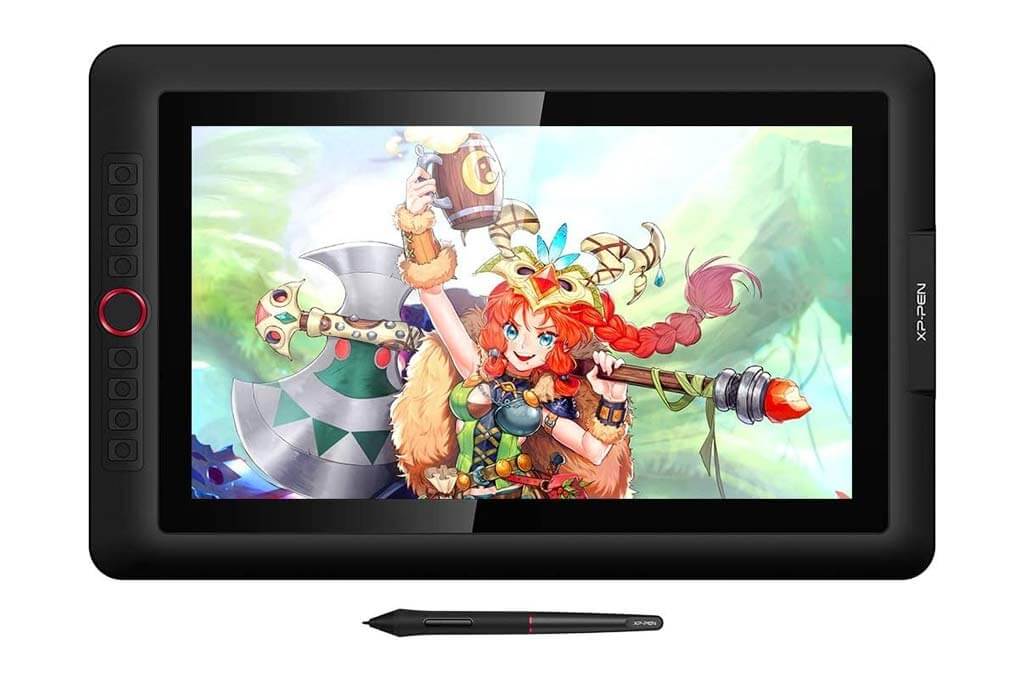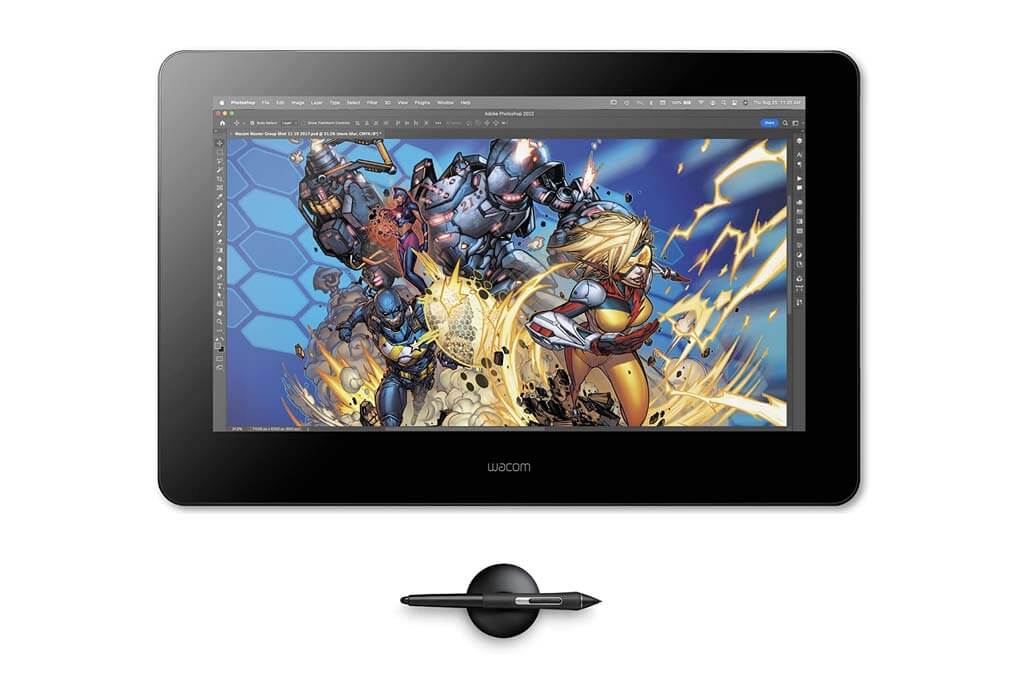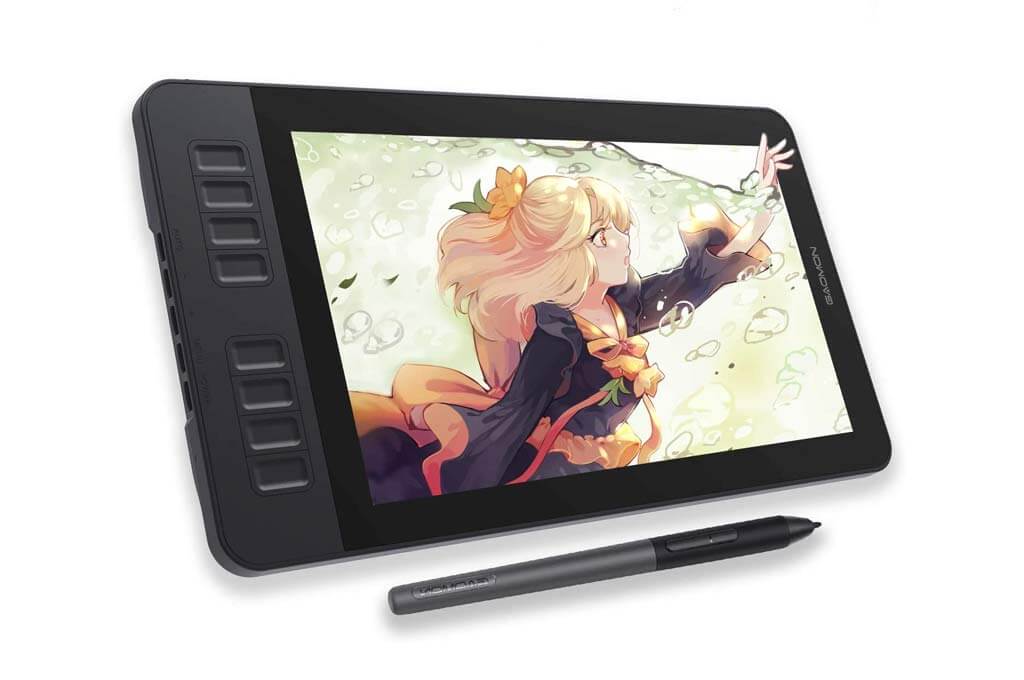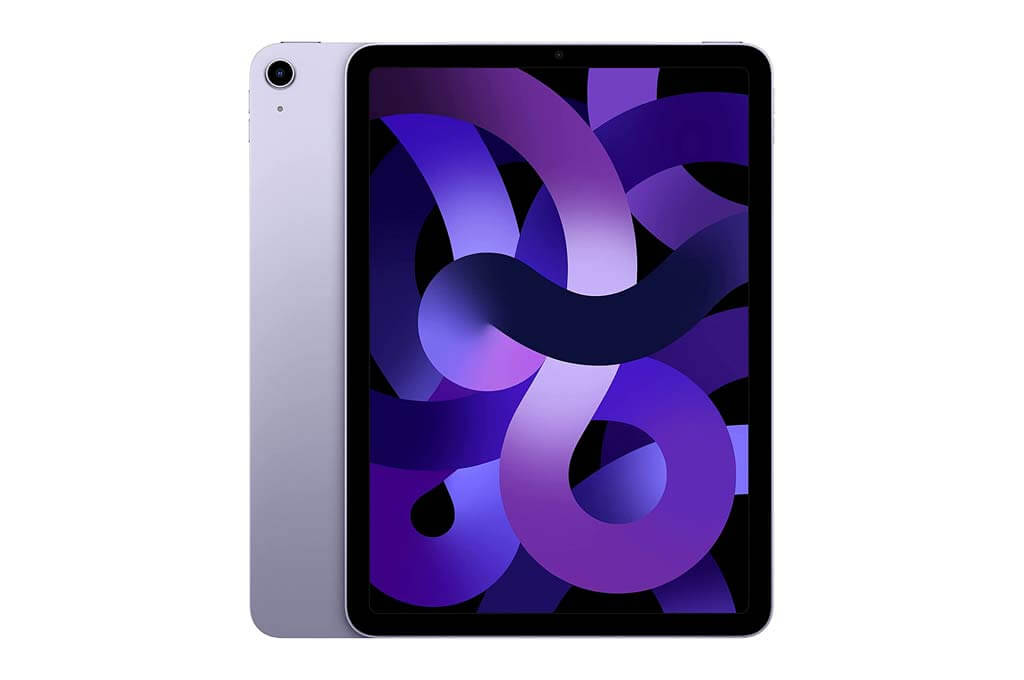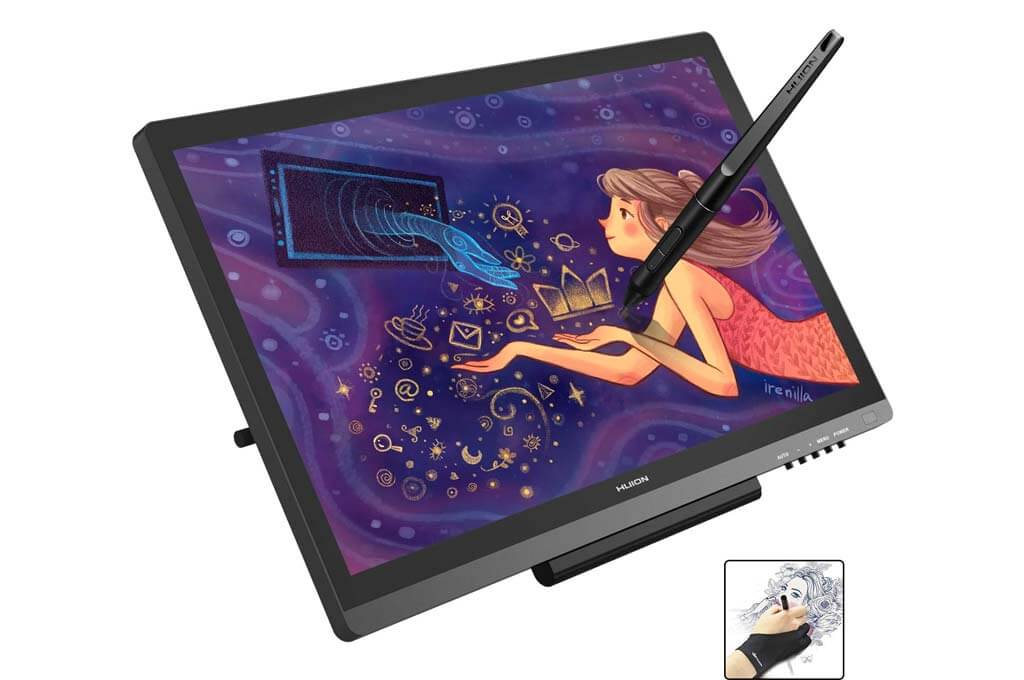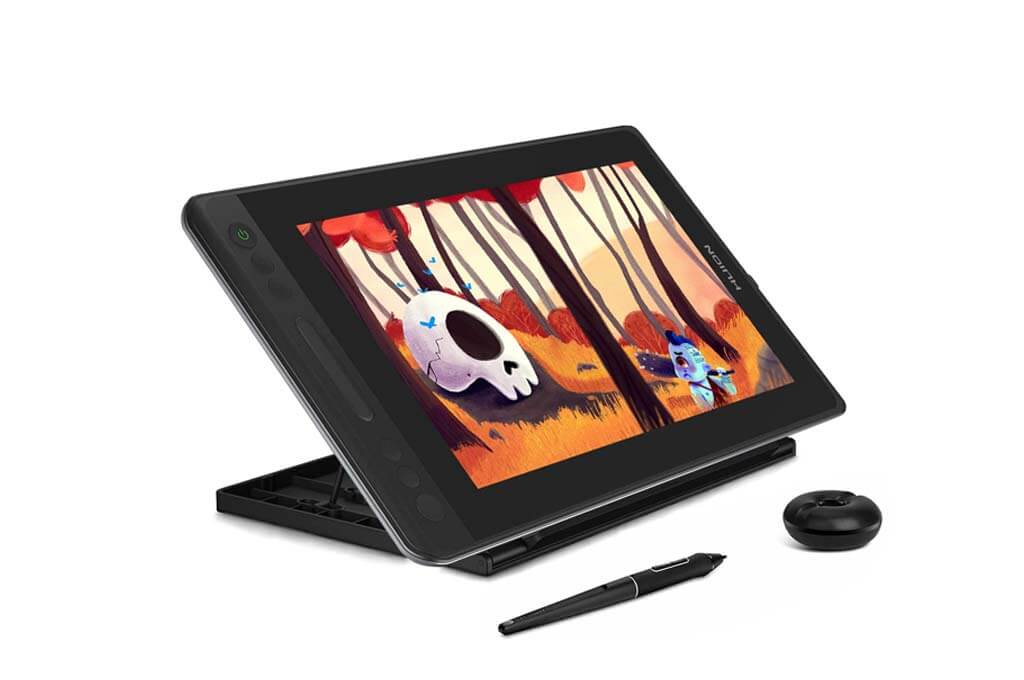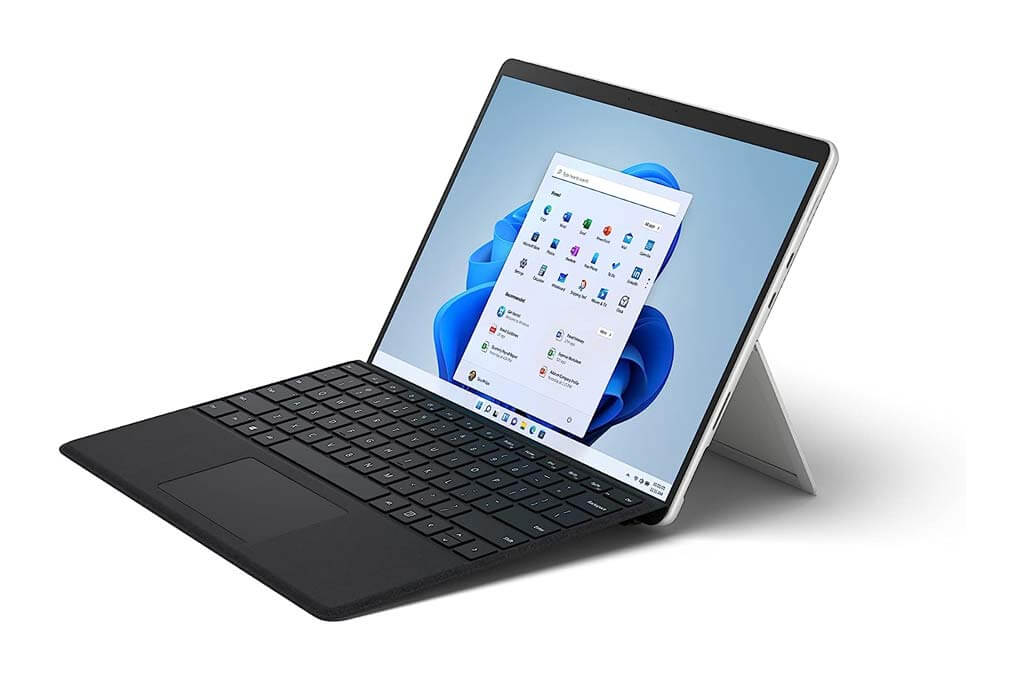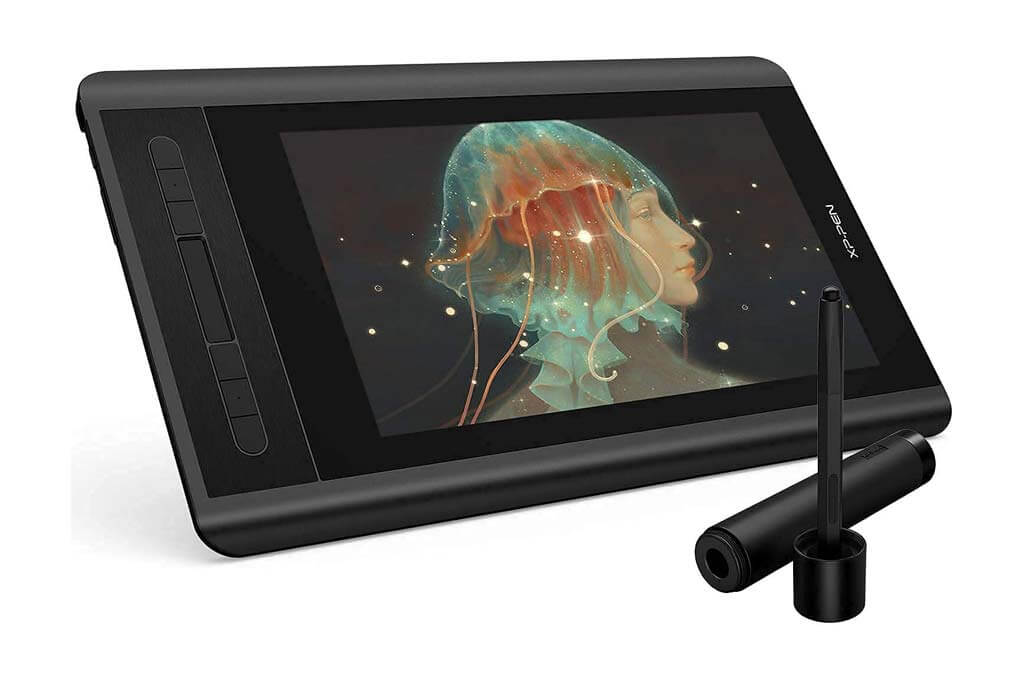The Designest may receive compensation from companies, products, and services featured in this publication. For more details, please refer to our Affiliate Disclosure page.
Choosing the right drawing tablet with a screen can be a game-changer in your digital art journey. These tablets, often called pen displays, provide an intuitive experience as you draw directly onto the screen, much like traditional paper sketching, but with the added benefits of digital tools.
The problem is, the market is flooded with an overwhelming variety of tablets, each promising an unparalleled creative experience — from flagship models like the Wacom Cintiq Pro series and the Apple iPad Pro to budget-friendly alternatives from brands like XP-Pen and Huion. Each device brings its unique mix of features, making the choice more complex than just comparing prices or brands.
I’ve taken the time to carefully curate a list of the top 12 drawing tablets with screens that have stood out in terms of performance, features, and user reviews. Whether you’re a professional looking for the crème de la crème of tablets, a hobbyist seeking a balance between cost and capability, or a beginner taking your first step into the digital art world, there’s a tablet here for you.
And remember: while you’re grappling with decisions about screen size, resolution, pressure sensitivity, or device compatibility, the ultimate goal is to find a tablet that complements your creative process rather than complicates it.
Top 3 Best Drawing Tablets With Screen
- 24-inch 4K resolution screen
- Highly-sensitive stylus (Pro Pen 2) with tilt recognition
- Remarkable color accuracy with a 98% Adobe RGB color gamut
- Supports customizable ExpressKeys and Radial Menu
- Multi-touch capabilities
- Anti-glare surface
- 12.9-inch Liquid Retina XDR display with 2732×2048-pixel resolution
- Excellent stylus (Apple Pencil)
- Vibrant, true-to-life colors
- Highly portable
- Allows comfortable work in various light conditions
- 15.6-inch laminated Full HD screen
- Highly-sensitive & battery-free stylus (PW507 digital pen) with ±60° tilt recognition
- Impressive color accuracy with 120% sRGB color gamut
- Comes with a stand
- Anti-glare glass
The Wacom Cintiq Pro 24 is the best drawing tablet with screen and a masterclass in design sophistication, offering an unrivaled immersive and intuitive experience for serious creatives.
Specifications
- Active drawing area: 24 x 13.5 in
- Resolution: 3840 x 2160 pixels (4K)
- Pen pressure sensitivity: 8,192 levels
- Connections: USB-C, DisplayPort, HDMI, and USB-A
Reasons to Buy
- Excellent display quality
- Highly-sensitive pen
- Spacious drawing area
- Versatile connectivity options
Reasons to Avoid
- Higher price range
- Large weight: 7.2 kg (15.8 lbs) without accessories
- Limited adjustment for the viewing angle
- Not an independent tablet
As a designer, I can say that the Wacom Cintiq Pro 24 is the best drawing tablet with screen for me — it simply provides an expansive space that allows my creativity to flow unrestrained. With its 4K resolution display, the level of detail I can achieve is second to none. The colors of this art tablet are precise and vivid, thanks to its 99% Adobe RGB color accuracy, making it an excellent choice for projects where color precision is key. What’s more, the size of this pen display lets you use it as an external monitor.
The Wacom Pro Pen 2 is included in the package. This pressure-sensitive pen (8,192 levels) with tilt recognition mimics traditional media tools beautifully. Paired with the anti-glare screen of this large drawing tablet, it has made my transition between traditional and digital art seamless.
The touch capability is a game-changer. Being able to intuitively manipulate my canvas with multi-touch gestures enhances my workflow efficiency significantly. It adds a level of immersion to the design process, making it feel more like working directly on a canvas or a sketchpad.
Another good point here is that, since it’s not an independent drawing tablet, you don’t have to worry about battery life and can use it with different operating systems — Mac OS, Windows PC, or any other preference — and not feel restrained by the lack of any digital art software. However, this also means that this pen display is primarily for working at home.
While the larger screen of this pen tablet can be excellent for some projects, it can also be seen as a drawback. For those with limited desk space, it can be a challenge to accommodate. Additionally, the weight makes it less portable than its smaller counterparts.
Despite its large size, Wacom doesn’t include an ergonomic stand in the package. I’ve found that an adjustable stand is almost necessary for the best experience with the Cintiq Pro 24, especially during long design sessions with your drawing tablet. The lack of this in the package is a slight disappointment.
One other issue that needs mentioning is the tablet’s cooling system. While it does its job of preventing overheating, the fan can get noisy during extensive, high-performance use. I’d appreciate it if Wacom could find a way to manage cooling while also minimizing the fan noise.
Let’s sum up: I believe the Wacom Cintiq Pro 24 is the best drawing tablet with screen. It stands apart from any other tablet with its expansive workspace, brilliant display, and responsive pen, making it a top choice for professional artists. If its size, lack of an included stand, and the cooling fan’s noise doesn’t bother you, you should go for it. However, keep in mind that it is one of the most expensive drawing tablets — in this compilation and in general.
The iPad Pro is unmatched in its versatility, combining the functionality of a high-end tablet with a top-tier drawing tool thanks to the precision of the Apple Pencil.
Specifications
- Active drawing area: 10.32 x 7.74 in
- Resolution: 2732 x 2048 pixels (Liquid Retina XDR display)
- Pen pressure sensitivity: Not specified (requires optional Apple Pencil)
- Additional features: ProMotion technology, True Tone display
- Connections: USB Type-C 4 (Thunderbolt 4), DisplayPort, magnetic connector
- OS: iPadOS 16.1, upgradable to iPadOS 16.5
Reasons to Buy
- Super-fast M2 processor
- High-quality display with excellent color accuracy
- Powerful performance and smooth user experience
- Wide range of creative apps available
- Portable and versatile for on-the-go creativity
Reasons to Avoid
- Higher price range compared to other tablets
- Limited compatibility with certain professional software
- File management not as robust as on a desktop OS
- Apple Pencil has to be purchased separately
The iPad Pro M2 is truly a canvas that comes alive under your touch. Its 12.9-inch Liquid Retina XDR display is an immersive landscape where your designs can flourish in vivid detail. This isn’t just a large drawing tablet; it’s smart too, with a mini-LED backlit screen that dynamically adjusts the lighting for each pixel, offering sharper contrasts and deeper blacks.
The resolution is just amazing — at 2732×2048 pixels, you’ll be designing with precision that makes your creations pop, down to the finest detail. This iPad Pro also includes ProMotion technology, which ensures a smooth, fluid visual experience, whether you’re drawing delicate linework or creating complex 3D models.
The wide color gamut (P3) and True Tone technology ensure that your colors are accurate, vibrant, and true-to-life, irrespective of the surrounding light conditions. The fully laminated and anti-glare screen means that you can comfortably work on your drawing tablet in a variety of environments: from a sunny park to a dimly lit room.
The new M2 chip has a 15% faster CPU and 35% faster GPU compared to the M1 version. This means the new iPad Pro will provide you with truly endless capabilities when it comes to processing power. What’s also new is the default hover mode of the Apple Pencil, which can be especially useful for artists who create line art. New features in iPadOS 16 like full external display support and Reference Mode take pro workflows on iPad even further.
The second-generation Apple Pencil is what really sets the iPad Pro apart for me as a designer. The pencil’s precision, pressure sensitivity, and tilt functionality make drawing and designing feel incredibly natural. The magnetic attachment and charging of the Apple Pencil to the iPad Pro is an impressive addition, ensuring it’s always ready for use.
The integration with iOS (or iPadOS) means that I have access to a wide range of professional-level apps like Procreate, Adobe Fresco, or Affinity Designer. These applications transform the iPad Pro into a versatile design studio.
However, the iPad Pro isn’t without its limitations. While iPadOS has made strides in functionality, it can still feel restrictive compared to a full desktop OS when it comes to certain tasks, especially if your work requires specific digital art software unavailable on the platform. Additionally, the Apple Pencil is sold separately, which is an extra cost to factor in, compared to some other drawing tablets.
Storage could also be a potential issue for some. High-resolution design files can quickly fill up space, and opting for a larger capacity iPad Pro can get quite expensive.
Let’s sum up: the Apple iPad Pro M2 redefines what a portable tablet can achieve for creative professionals. It does come at a higher price point, but its exceptional performance and premium build quality justify the investment for graphic designers seeking a portable and versatile creative tool.
The Huion Kamvas Pro 16 excels in providing a high-quality, fully laminated display with an excellent balance of affordability and functionality.
Specifications
- Active drawing area: 15.6 x 9.4 in
- Resolution: 1920 x 1080 pixels (Full HD)
- Pen pressure sensitivity: 8,192 levels
- Connections: 3-in-1 USB-C port (HDMI signal)
Reasons to Buy
- Affordable option with good features
- Compact and portable design
- Highly-sensitive pen
- Suitable for digital artists on a budget
Reasons to Avoid
- Lower display resolution compared to higher-end models
- Limited connectivity options
- Not a standalone tablet
The 15.6-inch Full HD screen provides a broad canvas for my projects, and the 120% sRGB color gamut makes color-critical design work manageable. While not reaching the highs of a 4K display, it still provides sufficient resolution for most design tasks.
The battery-free pen with 8,192 levels of pressure sensitivity and ±60° tilt recognition has proven to be a high-quality tool. It emulates the feeling of drawing on paper well, capturing the nuances of my strokes. The pen’s performance, coupled with the anti-glare etched glass screen, offers an intuitive and natural drawing experience. Six customizable express keys and a touch bar on the side make my work even better.
However, there are a few things that could use improvement. The Huion Kamvas Pro 16 doesn’t support multi-touch, a feature I’ve found helpful on other drawing tablet models for intuitively navigating and manipulating my workspace.
Also, the stand isn’t included in the box and needs to be purchased separately. Given the tablet’s size, having an adjustable stand is the only way I could use it in prolonged drawing sessions.
The Kamvas Pro 16 package includes the tablet, a battery-free pen, a donut-shaped pen holder with replacement nibs inside, a 3-in-1 cable for connection, a power adapter, and a cleaning cloth.
Let’s sum up: the Huion Kamvas Pro 16 offers excellent value for its price. It delivers a reliable and enjoyable drawing experience with its high-quality pen, vibrant display, and customizable shortcut keys. Despite the lack of touch support and the separate purchase for a stand, it’s a solid choice for designers in need of a capable yet reasonably priced drawing tablet.
Specifications
- Active drawing area: 11.6 x 6.5 in
- Resolution: 1920 x 1080 pixels (Full HD)
- Pen pressure sensitivity: 8,192 levels
- Connections: USB-C
Reasons to Buy
- Crisp display quality
- Highly-sensitive pen
- Portability
- Compatibility with popular software
- Budget-friendly price
Reasons to Avoid
- Not a standalone tablet
- Lower display resolution compared to higher-end models
- Smaller drawing surface
The drawing tablet features a Full HD laminated screen that delivers crisp and clear images you’ll enjoy in your digital drawing. With an 88% NTSC (Adobe RGB≧91%,sRGB≧123%) color accuracy, it might not be as high as the Wacom Cintiq Pro series, but it’s more than satisfactory for most tasks, offering vibrant and accurate colors.
The stylus, which boasts 8,192 levels of pressure sensitivity and 60 degrees of tilt function, impresses me with its fluidity and precision. It offers a seamless drawing experience that replicates the feel of traditional media quite effectively.
One of the features I value most is the addition of a dial and eight customizable shortcut keys on the tablet. These have made a significant difference to my workflow, providing quick and easy access to my most-used functions and tools.
However, the XP-Pen Artist 13.3 Pro is not without its shortcomings. Unlike some of the higher-end models, this tablet lacks touch capabilities, meaning all navigation must be done using the stylus or shortcut keys. This isn’t a deal-breaker, but it does take away a degree of intuitiveness that I’ve enjoyed in other models.
The stand provided is a nice addition, but it only offers one angle of elevation, which may not be ideal for everyone. I would have appreciated a more versatile stand for the sake of ergonomics. Also, note that the key strength of the Artist 13.3 Pro lies in its affordability. Positioned in the mid-range price category, it provides a great-value option for artists who desire a quality drawing tablet without stretching their budget.
Let’s sum up: the XP-Pen Artist 13.3 Pro is a portable drawing tablet with superior pen pressure sensitivity and a fully laminated display — and the customizable express keys and the red dial interface only add to its appeal. While the absence of a stand and a touch bar is personally a setback for me, its competitive price point makes it one of the best drawing tablets at this price point.
Specifications
- Active drawing area: 13.54 x 7.62 in
- Resolution: 1920 x 1080 pixels (Full HD)
- Pen pressure sensitivity: 8,192 levels
- Connections: USB Type-C
Reasons to Buy
- Large active drawing area
- High-quality screen
- Highly-sensitive pen
- Customizable shortcut keys and innovative red dial
Reasons to Avoid
- Reduced portability due to size
- Stand not included
- Lack of multi-touch functionality
This graphics tablet has a 15.6-inch Full HD display, providing a larger canvas that allows me to work on details without frequently zooming in and out. The laminated screen supports a 120% sRGB color gamut, ensuring vibrant colors and greater accuracy, a significant asset in color-critical design work.
The pen that comes with the drawing tablet is battery-free, which means I don’t have to worry about charging it in the middle of my work. With 8,192 levels of pressure sensitivity and ±60° tilt recognition, it captures my strokes with high precision, offering a natural drawing experience similar to traditional media.
Just like in 13.3 Pro, the Artist 15.6 Pro excels with its red dial interface coupled and eight customizable shortcut keys. I’ll say it again: this combination has improved my workflow tremendously, allowing quick access to commands and easy adjustments.
Despite its larger size providing a beneficial workspace, it does limit the portability of the Artist 15.6 Pro. It’s not as convenient to carry around as smaller tablets. Also, unlike the smaller Artist 13.3 Pro, it doesn’t come with a stand, which needs to be purchased separately if you prefer drawing at an angle.
Also, while the pen performance is impressive, the tablet lacks multi-touch functionality. If you’re accustomed to using touch gestures in your workflow, this might be a limitation.
Let’s sum up: the XP-PEN Artist 15.6 Pro stands out for its generous workspace, vibrant display, and dynamic shortcut features. It’s an excellent option for designers prioritizing a larger drawing area and efficient controls, but portability and touch gesture controls should be taken into consideration.
Specifications
- Active drawing area: 15.6 x 8.8 in
- Resolution: 3840 x 2160 pixels
- Pen pressure sensitivity: 8,192 levels
- Connections: USB-C
Reasons to Buy
- Portability
- High-resolution display
- Pen pressure sensitivity
Reasons to Avoid
- Higher price compared to similar options
- Stand not included
As a designer, I’m impressed with the Wacom Cintiq Pro 16. The tool greatly enhances my workflow, starting from its 4K resolution display that makes every detail of my work exceptionally clear and vivid. The wide color gamut accurately represents the colors I choose, which is crucial when working on projects requiring precise color matching.
The Pro Pen 2, included in the set, feels like an extension of my hand. With its 8,192 pressure levels and excellent tilt sensitivity, it’s as close to traditional media as a digital tool can get. The nuanced control of the pen makes for a truly amazing drawing experience.
One feature that deserves special mention is the touch sensitivity and multi-touch support of the tablet. It helps streamline my workflow, allowing me to zoom in and out, rotate my canvas, and perform other commands intuitively with my fingers, keeping the workflow fluid and dynamic.
However, there are a couple of points where the Cintiq Pro 16 could improve. I’ve found the device to be a bit bulky. While it’s by no means unmanageable, a sleeker design would have been appreciated. Also, prolonged work sessions can become uncomfortable without an included stand. I’d recommend investing in one, but it would have been convenient if Wacom had included it in the package.
Additionally, while not a significant disruption, the occasional fan noise can sometimes pull me out of my focused state while creating digital art. I understand that cooling is necessary for a device with these capabilities, but a quieter solution would have been appreciated.
Let’s sum up: the Wacom Cintiq Pro 16 is a powerful tool for designers. Despite a few ergonomic shortcomings and fan noise, it can significantly improve your design process. The precise pen and stunning display quality make it a worthwhile investment.
Specifications
- Active Drawing Area: 10.09 x 5.68 in
- Resolution: 1920 x 1080 pixels (Full HD)
- Pen Pressure Sensitivity: 8,192 levels
- Connections: USB-A
Reasons to Buy
- Affordability
- Good resolution display
- High pen pressure sensitivity
Reasons to Avoid
- Stand only offers one angle
- Color accuracy not as high as pricier options
- No touch input
Starting with the display, the PD1161 sports an 11.6-inch IPS screen, which is considerably smaller than the Wacom Cintiq Pro 24, for example, but it suits my needs well, especially when working on the go. The display is crisp and bright, with a 1920×1080 resolution that is enough for detailed work, though not as impressive as the 4K resolution of higher-end models.
The pen has 8,192 levels of pressure sensitivity, just like in styluses of high-end drawing tablets. The eight shortcut keys and roller wheel on the tablet’s side are customizable, providing quick access to tools and enhancing my productivity.
A few points could be improved, though. The color accuracy isn’t as strong as on more expensive models. While sufficient for many projects, if you are working on a project where color precision is crucial, you might notice the difference. The stand provided is also somewhat basic, offering only one viewing angle, which may not be comfortable for everyone.
Additionally, the GAOMON PD1161 doesn’t support touch input. I do miss the ability to use my fingers to rotate and resize the canvas (one of the solid reasons to switch from paper to a digital drawing tablet per se) something that comes with higher-end models. It’s also worth noting that the PD1161 is a wired tablet, which may limit mobility for some users.
In the box, the drawing tablet comes with a battery-free pen, a pen holder, replacement nibs, a drawing glove, and the necessary cables for connection. It’s a comprehensive package that gives you everything you need to start working.
Let’s sum up: while lacking some of the high-end features like touch input and superior color accuracy, this great-value pen display makes up for it with a comfortable stylus, customizable shortcut keys, and portability. This is an excellent entry-level drawing tablet for any digital artists who are just starting their creative journey or for those who seek a second screen.
Specifications
- Active drawing area: ~9.74 x 7.5 in
- Resolution: 2360 x 1640 pixels (Liquid Retina Display)
- Connections: USB-C
- Operating System: iPadOS
Reasons to Buy
- Good resolution display
- Robust app ecosystem
- Portability
Reasons to Avoid
- No ProMotion technology (120Hz refresh rate)
- Limited compatibility with certain professional software
- File management not as robust as on a desktop OS
- Apple Pencil has to be purchsed separately
The iPad Air features a 10.9-inch Liquid Retina display. It’s a bit smaller than the iPad Pro, but it still provides ample room for design work. The screen is bright, colorful, and highly responsive, providing a smooth drawing experience.
Like its Pro sibling, the iPad Air supports the 2nd Generation Apple Pencil, which is a fantastic tool for drawing. iPadOS and the wealth of available creative apps like Procreate, Affinity Designer, and Adobe Fresco transform the iPad Air into a mobile art studio. It’s incredibly beneficial to be able to sketch or design whenever inspiration strikes, without being tethered to a desk.
This tablet, however, is not without its drawbacks. The main one is that it doesn’t feature the ProMotion technology (120Hz refresh rate) found in the Pro series, so it’s slightly less smooth in comparison. And just like the iPad Pro, it doesn’t come with the included Apple Pencil, so you’ll have to budget in this extra expense. And, again, remember the limitations of iPadOS.
Let’s sum up: I found the Apple iPad Air to be a versatile and capable pen display for graphic designers seeking a portable and intuitive experience. Despite some limitations, its performance, coupled with the Apple Pencil and the iPadOS ecosystem, makes it an excellent tablet for drawing and design work. Unless you need a super powerful performance from your tablet, you can opt for the iPad Air as a cheaper alternative to iPad Pro. If you’re not a passionate Android devices fan for life, then this drawing tablet has a high chance of conquering your artistic soul.
Renowned for its large display and responsiveness, the Huion Kamvas GT-191V2 offers an immersive drawing experience, ideal for those seeking a broad workspace.
Specifications
- Active drawing area: 17.1 x 9.4 in
- Resolution: 1920 x 1080 pixels (Full HD)
- Pen pressure sensitivity: 8,192 levels
- Connections: HDMI, USB-A
Reasons to Buy
- Affordable price
- Large active drawing area
- High pen pressure sensitivity
- Stand included
Reasons to Avoid
- No express keys or touch bar
- Lack of touch input
- Not easily portable due to size and weight
The GT-191V2 boasts a generous 19.5-inch screen, providing a spacious canvas for detailed design work. The display has a Full HD resolution of 1920 x 1080 pixels, which, while not as sharp as higher-end models, still presents crisp and vibrant visuals adequate for most design tasks.
The drawing experience on the GT-191V2 is commendable, largely due to the battery-free stylus, which provides 8,192 levels of pressure sensitivity. This ensures my strokes are accurately captured, from the lightest touch to the most forceful lines. The pen also has a ±60° tilt support, adding a sense of depth and perspective to my work.
The GT-191V2 doesn’t offer any express keys or touch bars. While not a deal-breaker, it does mean relying heavily on keyboard shortcuts or the software interface for quick tool access. If you’re accustomed to using shortcut keys on the tablet, this might be a slight inconvenience.
While the GT-191V2 doesn’t have touch input, I didn’t miss this feature too much, as I primarily use the pen for interaction. Nonetheless, some designers might find the lack of this feature a limitation.
One important aspect to note is the tablet’s weight and size. It’s quite hefty and not the most portable, so it’s more suitable for a stationary setup. It also comes with an adjustable stand, which I find essential for long work hours, helping maintain a comfortable posture.
Let’s sum up: the Huion Kamvas GT-191V2, while lacking some premium features, provides a compelling drawing experience at an affordable price point. Its large screen, effective stylus, and comfortable stand make it a solid choice for designers seeking a stationary drawing tablet.
Specifications
- Active drawing area: 11.56 x 6.5 in
- Resolution: 1920 x 1080 pixels (Full HD)
- Pen pressure sensitivity: 8,192 levels
- Connections: 3-in-1 cable with HDMI, USB-A, and power connections
Reasons to Buy
- Compact and portable
- High-quality laminated display
- High pen pressure sensitivity
- Customizable express keys and touch bar
Reasons to Avoid
- No full touch screen functionality
- Stand sold separately
The Kamvas Pro 13 features a 13.3-inch Full HD display, which provides a generous active drawing area. The display is laminated, which significantly reduces parallax, and it supports a 120% sRGB color gamut. These features ensure that the colors are vibrant and accurate, and my stylus tip aligns with the cursor accurately, making detailed work more precise.
The battery-free stylus that comes with the drawing tablet has a pressure sensitivity of 8,192 levels, along with a ±60° tilt function. It allows me to create detailed artwork with a wide range of lines and strokes, mimicking traditional drawing methods.
The Kamvas Pro 13 includes a touch bar and four customizable express keys. This is extremely helpful, as I can program my most frequently used shortcuts into these keys, streamlining my workflow.
While this tablet is robust and packed with features, it isn’t perfect. Although it offers a touch bar, it doesn’t support full touch screen functionality. Some designers may miss the ability to use gestures to rotate, zoom, and pan their canvas. Additionally, the stand needs to be purchased separately, an extra expense to consider.
Let’s sum up: the Huion Kamvas Pro 13 strikes a good balance between functionality, portability, and price. It offers excellent pen performance and a good-quality screen. Despite a few drawbacks, it’s a compelling choice for designers in need of a compact but capable graphic tablet.
Specifications
- Active drawing area: 11.3 x 7.5 in
- Resolution: 2880 x 1920 pixels
- Pen pressure sensitivity: 4096 levels with Surface Pen (sold separately)
- Connections: 2 x USB-C with USB 4.0/Thunderbolt™ 4, Surface Connect port, 3.5mm headphone jack, 1 x nano SIM
Reasons to Buy
- Versatile as a standalone tablet and a drawing device
- High-resolution PixelSense™ Flow Display
- Compatibility with Surface Pen
- Portable and lightweight design
Reasons to Avoid
- Surface Pen sold separately
- Limited drawing area compared to larger tablets
- Higher price range
- Less focus on the needs of digital artists compared to specialized drawing tablets
As a designer who values versatility and functionality, the Microsoft Surface Pro 8 has managed to impress me. Treading the line between a laptop and a drawing tablet, it brings an unparalleled blend of mobility, power, and design capabilities to the table (literally).
Firstly, the 13-inch PixelSense Flow display offers a great canvas for creating artwork — whether I sketch or edit images. With a resolution of 2880 x 1920 pixels, the visuals are crisp and clear.
Color accuracy is important in my line of work, and the Surface Pro 8 delivers in this regard. With a wide color gamut, I can trust that the colors I select on the screen will match my final output.
I love the fact that the Surface Pro 8 gives me the power of a full-fledged computer in a tablet form factor. This means it can serve as an excellent second screen. Plus, I can run a desktop version of graphic design software like Adobe Photoshop or Illustrator, something not all drawing tablets can boast.
Now, while the Surface Pro 8 is a powerful tablet, it’s not without its downsides. The Surface Pen is not included in the pack, which adds to the overall cost. What’s more, its pen’s 4096 levels of pressure sensitivity are less than in other tablets with a screen I’ve reviewed. There’s also the issue of port placements — they can feel a bit awkward if you’re using the device in portrait mode.
Let’s sum up: despite the slight shortcomings, the Surface Pro 8 is a high-quality drawing tablet and a good choice for designers. Having a device that functions both as a pen display and a laptop is a nice bonus for me and something that stands out in the crowd of dedicated drawing tablets.
Specifications
- Active drawing area: 10.09 x 5.67 in
- Resolution: 1920 x 1080 pixels (Full HD)
- Pen pressure sensitivity: 8,192 levels
- Connections: USB Type-C
Reasons to Buy
- Compact and portable
- High-resolution display
- High pen pressure sensitivity
- Customizable shortcut keys and touch bar
- Anti-reflective coating for reduced glare
Reasons to Avoid
- Size may be limiting for larger designs
- Stand not included
- Possible need for color calibration out of the box
The Artist 12 comes with a compact but sufficiently sized 11.6-inch display, which can display vibrant colors thanks to its 72% NTSC color gamut. The Full HD resolution provides enough detail to allow me to work confidently on my designs, ensuring clarity for intricate details.
The Artist 12’s battery-free stylus is an important aspect of its performance. It has 8,192 levels of pressure sensitivity and a 266RPS report rate, which allows for precise lines and smooth curves without lag. It also comes with six express keys and a touch bar that are customizable.
One unique feature of the Artist 12 is its anti-reflective coating, which not only reduces glare but also provides a paper-like drawing feel. This is a welcome feature that adds comfort during prolonged drawing sessions.
However, the compact size of the Artist 12 can be a bit limiting when it comes to larger, more complex designs. For artists on the go, this can be the key criterion for choosing the tablet over others though. But keep in mind, I’ve also noticed that color calibration may be necessary right out of the box to achieve the most accurate color representation.
One last thing to note is the lack of a stand in the package. While the tablet is comfortable to use flat, you might need to purchase a stand separately if you prefer to work at an angle.
Let’s sum up: the XP-Pen Artist 12 is a high-quality, entry-level drawing tablet that is particularly suitable for those who prefer a more compact and portable device that doesn’t compromise on key features.
How To Make The Right Choice of a Drawing Tablet With Screen
There are a few things to consider when choosing a drawing tablet.
1. Your budget
If budget is a key concern, brands like XP-Pen and GAOMON offer quality pen displays at a lower price point. These tablets may not have all the advanced features of higher-end models, but they can still be excellent tools for both beginners and seasoned artists.
For professionals or those who prioritize a high-quality display, the Wacom Cintiq Pro series or Apple iPad Pro are top contenders. These boast top-of-the-line resolution, color accuracy, and pen sensitivity, providing a seamless drawing experience. However, these features come at a premium price.
2. Portability
If you frequently travel or draw on the go, a smaller, lighter pen display like the XP-Pen Artist 13.3 Pro or Apple iPad Air may be more suitable. Remember, while larger screens provide more workspace, they can also be heavier and less convenient to transport.
3. Screen size
When it comes to screen size, it’s all about your comfort. Larger graphic tablets like Huion Kamvas GT-191V2 or Wacom Cintiq Pro 24 offer expansive drawing areas, ideal for detailed work. Conversely, smaller models are often more than sufficient and can be easier to maneuver, especially for those new to digital art.
Remember that screen size must always be considered together with resolution. Big screens with lower resolution won’t provide a great level of detail.
4. Color accuracy
Color accuracy is important, especially if you’re doing work for print or multimedia that needs precise color matching. Look for pen display tablets with high color gamut ratings.
5. Stylus type
The pen you’ll be using can make a big difference. Some are battery-operated, others need to be charged, and some require no power at all. The pen’s shape, weight, and whether it has an eraser or programmable buttons can also affect your drawing experience.
6. Software compatibility
Be sure that the pen display tablet you choose is compatible with your preferred creative software. Most drawing tablets support popular programs like Photoshop and Illustrator, but it’s always best to check.
Among other tips, I’d say look for user reviews and the reputation of the tablet among professionals in your field. Do not be afraid to seek advice from the artists you love — after all, they had to start somewhere, too, and, most probably, will be happy to share their expertise. Remember to also check the company’s reputation for customer service and the warranty offered. Drawing tablets aren’t cheap, and you must be sure you’ll get help if you need it. And finally, determine what you expect the most from your pen display and don’t go for fancy specs “just in case”.
Ultimately, the “right” drawing tablet with a screen is one that fits your personal needs and working style. If everyone says it’s good but something doesn’t feel quite right for you, the tablet is simply not your preference. Opt for all necessary specifications and trust your gut from there.
Frequently Asked Questions

